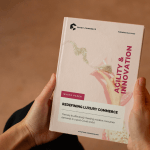As luxury brands begin to better integrate e-commerce, it is essential to invest in digital strategy. To successfully compete in omnichannel online sales, a company needs a digital strategy to identify weaknesses in its operations.
Customers no longer only have two options for interacting with a company. They have an array of choices including phones, webchats, social media, and more. Purchases, returns, and customer service are all being performed fluidly across all interfacing options. In an attempt to keep up with the growing technology options and customer demands, companies have begun to adapt.
Omnichannel Retail Experience
A multichannel approach to customer service supports a range of channels, meeting each customer’s needs. Allowing consumers to choose where they do business contributes to a personalized shopping experience. Multichannel does, unfortunately, come with pitfalls. If a customer reaches out on one platform and then later reaches out on another, the records don’t cross over. The customer has to start back at the beginning, repeating their concerns.
Omnichannel fixes this issue by creating an interconnected experience. Customers are provided with a seamless service experience across all channels, digital and in-person. Integrating available customer service, marketing & sales channels provides continuity across the entire consumer journey. Customer history is stored in a single location, and accessible from any interface. Consumers can switch between platforms and channels seamlessly, picking up where they left off previously.
Omnichannel has the benefits of:
- Increasing Customer Loyalty
- A satisfied customer is usually a loyal customer. Omnichannel removes the barriers between channels, creating consistent hassle from experience. The unified customer service shares seamlessly between mobile, social media, in-person, and desktop, promoting better customer relations.
- Reducing Operational Costs
- Separate channels require multiple agents to manage information silos across different departments. Communication between departments breaks down when relevant information fails to be shared. Multiple agents coordinating efforts on a single issue creates redundancy and drives up costs. Omnichannel lowers costs by ensuring all information is streamlined and agents are able to work in support of one another.
- Convenient Consistency
- Omnichannel is convenient not just for buyers but for customer service as well. It doesn’t matter how a customer contacts the store. Communication in-person, over the phone, or via messenger is all recorded in the same customer file. The file is accessible to all agents, allowing them to continue conversations across all platforms without a hitch. Prior conversations and purchase history are easily accessible, providing better and more relevant service.
Transitioning to omnichannel isn’t necessarily easy but investing in a custom storefront solution can take some of the pressure off. The effort to benefit you and your customers will be worth it in the end. It is important to completely understand the preferences of the customer demographic. Garner feedback over social media from consumers so you can better tailor it to their needs. Where are customers spending their time online and how do they prefer to communicate? These answers will help guide the designs of each channel.
A well-implemented omnichannel experience is a strategy that serves its consumers best.
Choosing a headless commerce approach provides retailers the agility necessary to keep pace with these emerging e-commerce trends. A headless e-commerce architecture will enable brands to create an immersive omnichannel experience.
What is headless commerce?
Headless commerce is an e-commerce architecture that separates the frontend and backend, allowing them to function separately. The front-end is the presentation layer of the website: what customers see and the technology that supports it. The backend is management functions and server data. This allows brands to develop and integrate the services and features they need to improve their customer experience more easily.
Headless commerce allows you to combine several sources of content and data to create a user journey that suits both your needs and that of the consumers. In the age of personalization, specialized products have been created to provide quality, unique content. Businesses are less limited by technological solutions, using new tools to better adapt their interface. A headless frontend can aggregate data from different solutions used for different functions of a platform.
Keeping ahead of expectations and engage customers with innovative strategies speeds up time to market and shortens development time. Updates to the front-end templates get stuck waiting for development queues to catch up. The headless approach allows new creative plans to be uploaded without backend intervention.
Retailers today must consider the customer first to continue growing and expanding.
Using headless commerce assists with creating a customer-led experience. Developers use APIs to create coordinated, consistent experiences across platforms. This leaves designers and creative teams free to concentrate on improving customer engagement and personalizing the experience.

Combining headless commerce & omnichannel
Omnichannel and headless commerce make it possible to create a customer experience that is functional for the retailer as well. The different channels that can be included are:
- Messaging
This allows customers to communicate in real-time text-based messages as a simple way to get in touch for support and answers to questions.
- Contact Forms
Web-based contact forms create formulated requests that are sent to the relevant team for resolution.
- Virtual Assistant
An intelligent chatbot uses natural language interpretation to infer a customer’s needs. They have pre-prescribed automated conversations that deal with simple questions and issues. This frees up support agents to help with other issues and provides a basic level of customer service when an agent is unavailable. They are programmed to pass on information to a live person when they have exceeded the programmed knowledge.
- Live Chat
This option is usually integrated into a website to provide quick and easy support. Customers can reach out and discuss an issue or ask a question by using the provided chatbox. It’s easy to implement and offers twenty-four-hour support to buyers.
Email may seem oddly slow in the world of instant chat but it can actually be a convenient channel. Email is still widely used by customers in almost every industry. The emails do take time and attention to process, so some automation to the system helps keep the wait time down.
- Phone
Like email, a phone call may feel obsolete but is still widely used for communication. Older demographics prefer to call a business directly for support. Often an omnichannel approach will use self-service through AI-driven language. With luxury brands though, customers prefer the natural touch of a human being speaking to them.
- Social Media
Especially for millennials and Generation Z, social media is an extremely accessible route for communicating with their desired brands. SM is also a fresh way to get a further reach.

